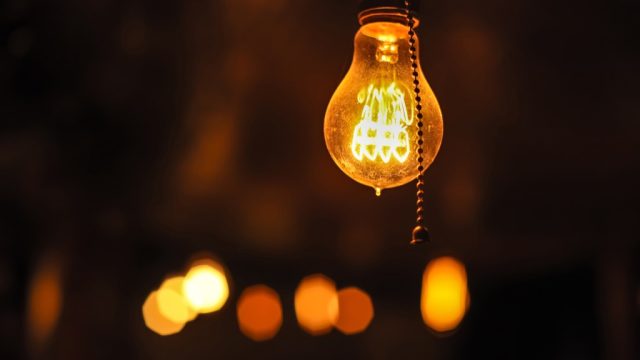This Is Why Light Bulbs Pop When They’re Dead

We’ve all been there: you’re curled up in bed with a good book, only to be startled back into reality by the loud pop of your light bulb and sudden darkness. The bulk of the 2.5 billion light bulbs sold each year—that’s 5.5 million each day—are still incandescents, which tend to produce a signature pop when they’re down for the count.
So, what’s behind that jarring popping sound, exactly?
The electricity in an incandescent bulb travels through a vertical wire across a tungsten filament—the horizontal part of the bulb—and down the second contact wire. The tungsten in the filament provides a fair amount of resistance to the electricity that’s traveling through it, and it’s this friction that causes it to glow. However, all that resistance puts a lot of wear and tear on the filament over time, and when this tightly-stretched wire breaks, it makes that familiar pop.
Temperature variations on an incandescent bulb’s surface will occasionally cause it to do more than just emit a popping sound, however. Extreme temperatures that cause fragility in the bulb’s surface or a weak base that allows the delicate balance of gas inside the bulb to escape will cause incandescent bulbs to actually explode from time to time, just one of the reasons light bulbs are one of the 50 Deadliest Things in Your Home.
While there’s little to be done about the untimely demise of your incandescent bulbs, technological advances are making those old-school bulbs and their death knells all but obsolete. CFL bulbs, which produce light by introducing an electric current into an argon-filled tube hosting a tiny amount of mercury and a phosphor coating, have taken away a major proportion of incandescent bulbs’ market share over the past decade.
According to a 2017 report from the U.S. Energy Information Administration, 82 percent of American homes now report having CFLs in them, with 10 percent of homes relying solely on CFL lighting. The only downside? While these recyclable bulbs, which can last up to 10,000 hours apiece, are certainly more environmentally-friendly than their short-lived predecessors, broken bulbs potentially can expose users to small amounts of poisonous mercury.
Fortunately, CLFs aren’t the only energy savers on the market: LED bulbs, while more expensive than incandescent bulbs and CFLs, present a safer, more cost-effective solution in the long run. LEDs, or light-emitting diodes, produce a tiny amount of heat when compared to incandescent bulbs and CFLs, making them a popular choice for homes with children or those concerned about fire safety.
Better yet, they’re far and away the cheapest type of bulb to operate: while an incandescent bulb costs upwards of $8 to run over the course of a year, and a CFL costs approximately $1.75 to operate during that time, a year’s worth of LED operation will run you under a dollar. While their price point—up to $20 a bulb—may mean it takes some time for LEDs to catch on, it’s clear that they’re already rapidly becoming a fixture in American homes. EIA data suggests that 28 percent of U.S. households now have at least one LED bulb in them, with one percent of homes using entirely LEDs. Now, that’s a bright idea. And to learn more about the dangers lurking in the corners of your home, keep an eye out for the 20 Household Products That Could Be Dangerous.
To discover more amazing secrets about living your best life, click here to sign up for our FREE daily newsletter!